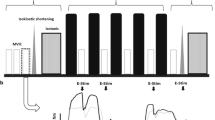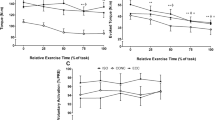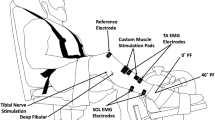Abstract
The human voluntary force:velocity relationship frequently fails to demonstrate the expected high eccentric forces. Possible explanations include unique activation strategies which might be affected by neural learning mechanisms. We investigated the effect of practicing eccentric contractions on (1) the force: velocity relationship of the human knee extensor muscles and (2) the extent of agonist and antagonist muscle activity. Eight healthy adults [seven women, group mean age 31 (SEM 5) years ± ] practised twice a week for 4 weeks using their non-dominant legs. Each session comprised three isokinetic concentric and eccentric maximal voluntary contractions (MVC) at randomised angular velocities of 100, 200 and 300° · s−1. Before and after, the force:velocity relationship was determined bilaterally (angular velocities 0–300° · s−1). There were no significant differences in the forces generated or relative electromyogram (EMG) activity after practice, although there was a trend for dynamic forces to increase. Beforehand, the bilateral eccentric MVC forces were lower than isometric (P < 0.0025); afterwards they were broadly similar. The agonist EMG was similar during isometric and eccentric contractions, but lower during concentric (P < 0.03). Antagonist EMG activity showed considerable individual variation, was similar during all contraction types and tended to be greater during dynamic contractions. These data indicate that neither central learning mechanisms nor total muscle activation strategies underlie the human failure to produce the expected high eccentric voluntary forces in humans.
Similar content being viewed by others
Author information
Authors and Affiliations
Additional information
Accepted: 19 September 2000
Rights and permissions
About this article
Cite this article
Rutherford, O., Purcell, C. & Newham, D. The human force:velocity relationship; activity in the knee flexor and extensor muscles before and after eccentric practice. Eur J Appl Physiol 84, 133–140 (2001). https://doi.org/10.1007/s004210000332
Issue Date:
DOI: https://doi.org/10.1007/s004210000332




